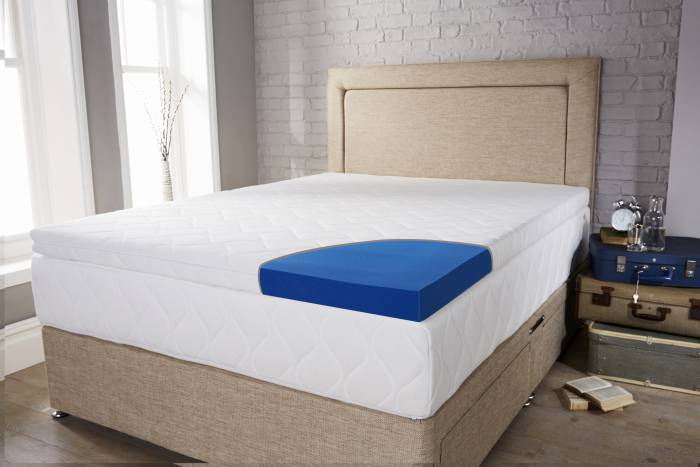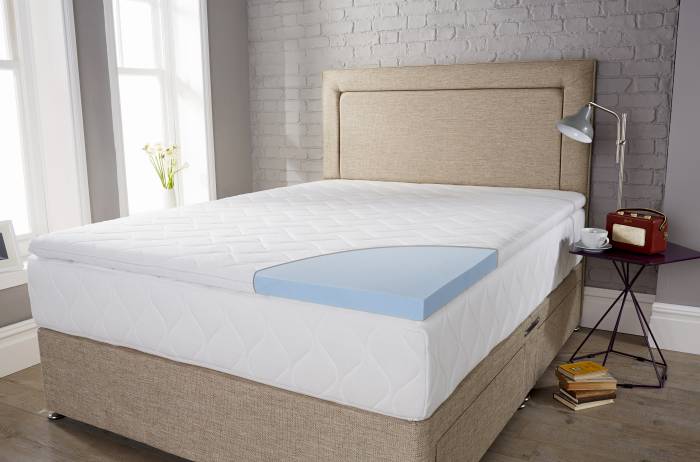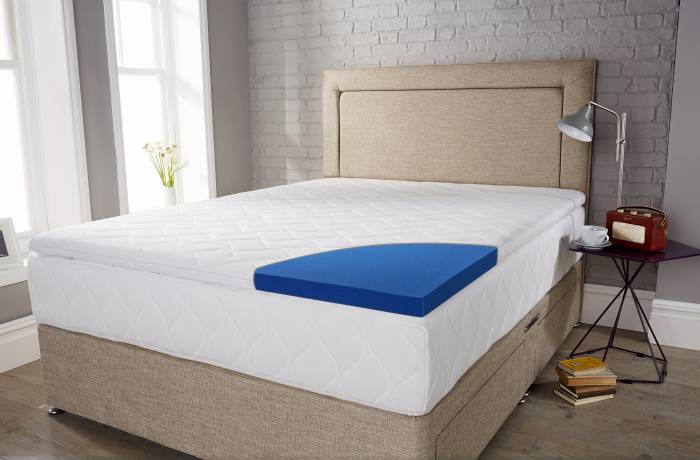Memory Foam & Hybrid Foam
July 2020Hybrid foams explained & boxed mattresses
Whilst memory foam and latex mattresses are the main foam bed contenders, if you look around you also will have seen other hybrid mattress materials, adding yet more materials to read up on. They have different properties to both memory foam and latex so it is worthwhile finding out exactly how they differ. With a plethora of new hybrid mattresses entering the marketplace at any one time it can be really confusing.

Boxed mattresses featuring gels and cooling foams alongside ‘revolutionary new hybrid foams’ are now available in the market, which further expands your search for the perfect mattress. Your inbox may be blowing up with different boxed mattress offers. Don’t despair, as we can help to simplify the selections you’re faced with in this hybrid foam guide.
Hybrid Mattress Foam Guide
- What is a hybrid foam mattress?
- What is viscoelastic foam?
- What hybrid mattress foams are there?
- What is Coolblue foam?
- What is Laygel foam?
- Brands of hybrid foam mattress
- Drawbacks of hybrid foam mattresses
- How much should I spend on a hybrid foam mattress?
- Top 5 hybrid mattress tips
What is a hybrid foam mattress?
The term “hybrid mattress” refers specifically to beds that combine coils with other materials like foam or latex. Both memory foam and latex have been used in mattresses for over 20 years, and in that time manufacturers have developed a number of other hybrid foams. Many bed retailers will only refer to these with their brand names or will incorrectly classify them as a memory foam (again confusing the area). At John Ryan, we class any foam that is not technically memory foam (viscoelastic) or latex as a hybrid foam. Referring to any of these foams as memory foam or an equivalent to natural latex is itself misleading. True memory foam softens and conforms in response to body heat. If a foam doesn’t rely on heat sensitivity, then it is likely a type of hybrid foam.
What is viscoelastic foam?
Viscoelastic foam is also known as memory foam, and it has its own unique properties that sets it apart from other foams. Its structure allows it to soften and react to heat and pressure; this is what gives memory foam its ability to conform to the body. The viscoelasticity comes from the foam’s open cell structure, which enables heat reaction. That is why memory foam and Tempur Pedic mattresses can get really warm. When warmed by body heat the open cell structure softens, allowing it to mould to the shape of the pressure exerted on it by a sleeper. As you may have guessed, there are again a number of different hybrid foams that offer similar properties and benefits to memory foam and latex. Although they are not usually viscoelastic, they do aim to provide pressure relief that’s similar to memory foam, and a number of them have managed to remove the disadvantages of memory foam (such as heat retention and rebound characteristics).
What hybrid mattress foams are there?
There are literally hundreds of different branded foams out there. Whether it’s the Emma mattress, Caspers ‘Latex equivalent’, Eve’s next-gen foam, or igel from Bensons for Beds, you’re going to be bombarded with options. The issue for consumers is that the details of what makes these foams unique is usually kept a secret. Companies don’t want to reveal the exact properties or chemical formulations of their patented foams. They argue this information is a protected trade secret. However, the issue is that, if you don’t know the exact depth of these hybrid foams, then you have no idea how suitable their mattresses are going to be for you in the long term.
We have uncovered plenty of detail about two-hybrid foams that perform really well. Here are the details of the two of them with their data sheets so you know exactly how to compare hybrid foams.
What is Coolblue?
Coolblue consists of an advanced PU-based foam.

It is less heat retentive when compared to memory foam, making it a cooler foam, but it will still be far warmer than a natural fibre mattress. It has a density of 70kg and is a firmer feel foam. Datasheets are really important when looking at a new hybrid mattress as this is the only way you can accurately compare them. Always make sure you ask any mattress retailer what the datasheet of the foams are.
This data must include:
- Density in KG of the foam
- Depth of each layer
- ILD / Hardness Rating
Hybrid foams are cooler than heat retentive memory foam
However, they still are far warmer than Natural Fibre Mattresses


Data sheet for Coolblue foam
| Foam Grade | Foam Type | Density Min KG/M3 | Density Max KG/M3 | Hardness Min (N) | Hardness Max (N) |
|---|---|---|---|---|---|
| Coolblue 70kg | Coolblue Hybrid Foam | 65 | 70 | 70 | 100 |
Density and hardness are quoted according to in-house test methods based on BS EN ISO 845 and BS EN ISO 2439 respectively.
What is Laygel?
Laygel is a Synthetic Latex equivalent. It has a similar feel to latex but without the price tag (given the fact it’s synthetic). It has an almost zero-viscoelastic threshold. This means it doesn’t rely on heat to mould like memory foam. Laygel moulds to the body but, unlike memory foam, it does not rely as heavily on heat to fully mould, meaning it does not get as hot as memory foam. Due to this, it also returns to its original shape much quicker, meaning you’re not left with an indentation on your mattress as it returns to form. Memory foam is often criticised by people who roll over during the night as they often get stuck in one position as it’s slow to react.
Laygel moulds to the body but, unlike memory foam, it does not rely as heavily on heat to fully mould, meaning it does not get as hot as memory foam. Due to this, it also returns to its original shape much quicker, meaning you’re not left with an indentation on your mattress as it returns to form. Memory foam is often criticised by people who roll over during the night as they often get stuck in one position as it’s slow to react.
Laygel removes this issue as it returns to its original form very quickly.
Laygel comes in a 60kg density, meaning its medium in firmness on its own. When coupled with other foams and reflex foam this can be tailored to a softer/firmer mattress.
Laygel Data Sheet
| Foam Grade | Foam Type | Density Min KG/M3 | Density Max KG/M3 | Hardness Min (N) | Hardness Max (N) |
|---|---|---|---|---|---|
| Laygel 60kg | Laygel Hybrid Foam | 57 | 63 | 100 | 150 |
Brands of Hybrid Foam Mattress
The marketplace has exploded with hundreds of new hybrid foam mattress options in recent years, and you may be wondering “where have they all come from?” The popularity of hybrid foams is driven by the fact that they are relatively cheap to produce and can be boxed for next day delivery. This means that a number of venture capitalists and investors have pumped money into new startups to get these fast products off the shelves in record time. This also means that the mattress expertise is often missing from these brands, which is why they are only selling one-size-fits-all one-sided mattresses. It’s a numbers game.

The following are all brands of hybrid mattress you may be familiar with:
- Casper Mattress
- Eve Mattress
- Simba Mattress
- Leesa mattress
- Emma Mattress
- MADE Mattress
- Otty Mattress
- Nectar Mattress
These companies all use unique branded foams in their hybrid mattress construction and will claim that they are universally comfortable for all sleeping styles. However, we all have varying needs when it comes to support, pressure relief and temperature regulation. Given these personal preferences, it is unlikely that any single mattress model can be an ideal fit for every sleeper. So, if you are considering one, evaluate whether they are suited to your own preferences and sleeping habits.
Drawbacks of Hybrid Foam Mattresses
Hybrid foam mattresses are fine up to a certain price point. They are cheap to produce, easy to roll and are a good entry-level option. However, if you’re spending £500 or more you can easily get a higher quality 2-sided mattress model for the same price. A 2-sided mattress will far outlast a one-sided hybrid mattress. It also means you can start to expect tailored spring tensions and more customisable fillings to match your sleep requirements more discerningly.
- Hybrid mattresses are always one-sided
- Hybrid mattresses don’t disclose the depth, density or types of foams they use
- Hybrid mattresses are far warmer than a pocket spring fibre mattress
- Rolling hybrid mattress models can end up damaging them
- Hybrid foam mattresses have zero edge support
- Hybrid mattress foams can’t be customised for your bodyweight
- They offer a one size fits all comfort
- Hybrid foams compress far faster than other fibres, leading to sagging and dipping
How much should I spend on a hybrid mattress?
Given the fact that hybrid foams are relatively cheap when compared to a natural fibre upholstery, the most you should be looking to spend on one is £500. If you’re spending more than this then you can get far more from a customisable 2-sided pocket sprung mattress. If you’re spending more than this you’re paying for the brand’s marketing and snazzy packaging, but not necessarily increasing the mattress’s quality!
| How much to spend on a double mattress? | What can I expect for my money? |
|---|---|
| Under £500 | Will not get you much at best a 13.5 gauge open coil/cage sprung with a thin polyester layer or a solid foam mattress. |
| £500 | Entry level spunbond springs with some form of synthetic upholstery. Usually one sided mattresses. |
| £750 | The beginnings of a basic pocket springs unit with 800 – 1000 count. No substantial amount of filling other than foams and synthetic materials. Two sided models. |
| £1000 | Should get you away from most low ranges and into the mid-range pocket spring models. |
| £1250 | Should get you a decent pocket sprung mattress with some Natural Fibre content. |
| £1500 | Should get you many manufacturers mid-range models with Natural Fibres |
| £1500-£2000 | Should get you a Hand Made primarily Natural Fibre Quality Mattress |
| £2000+ | You should expect 100% Natural Fibres and Traditional Hand Made Construction Method. |
| £5000+ | A Bespoke Hand Made Sleep System, High-end Spring Units & Featuring the Worlds Most Luxurious Natural Fibres. |
Have a look below at the best mattresses on offer for your price point with our detailed mattress reviews.
- What to expect from a £500 Mattress
- What to expect from a £750 Mattress
- What to expect from a £1000 Mattress
- What to expect from a £1250 Mattress
- What to expect from a £1500-£2000 Mattress
- What to expect from a £2000 Mattress
Hybrid Foam Top 5 Tips
1- Hybrid foams are the next generation of foam beds. Many remove some of the drawbacks of memory foam. Hybrid foams are often wrongly classed as memory foam but are really a foam in their own right. Only memory foam is viscoelastic (i.e. reacts to heat), whereas many hybrid foams are not viscoelastic.
2- Hybrid foams, such as Laygel and Coolblue, remove some of the memory foam heat retention issues. They are therefore cooler to sleep on than traditional memory foam as they don’t retain heat as much.
3 – They have better rebound rates than memory foam (i.e. return to their original shape quicker). This is a benefit for those that don’t like the mould that memory foam creates around your body. It also removes the indentation where some sleepers struggle to turn over once the memory foam has moulded.
4 – Hybrid foams are often hyped to have special scientific and space-age qualities. Phrases such as ‘intelligent heat dispersal’ are common. Use your judgement as to whether this is true. Our hybrid foams are cooler and have quicker rebound rates, which are the clear measurable difference. We disagree in selling a foam as intelligent or having its own ‘awareness’.
5 – You still need to consider the density, depth and quality of these hybrid foams just like any other material. If a retailer can’t give you these in confidence and explain the differences, then you may need to rethink that specific Hybrid foam/retailer as these factors are vital in choosing the correct mattress.
Summary
If you like the feel of memory foam but are put off by the heat retention and lack of response then a hybrid foam could be the answer. Not only are they far quicker to respond when you turn over, but they don’t retain as much heat, making them a cooler sleep surface when compared to memory foam.
However, they are always one-sided and do compress at an alarming rate. This may lead you to need to replace your mattress far more quickly than if you chose a pocket spring model. If you need any more advice please get in touch with us on 0161 437 4419.

Dreaming of the perfect nights sleep?

Ask us a question
There are over 6000 questions and answers submitted by you on all questions about mattresses and bed problems. Enter a keyword such as Vi Spring, John Lewis beds, bad back or Memory Foam and see if your question has already been answered.
If you can’t find an answer in knowledge hub, ask a new question. We aim to respond to all questions within one working day.
Newsletter
Enter your email to join our newsletter. We’ll send you occasional news and mattress expertise.
